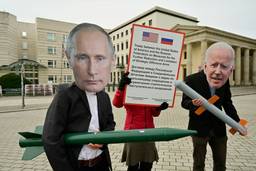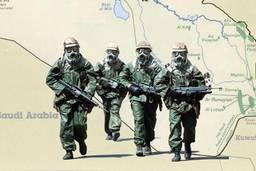
Clad in a leather bomber jacket and surrounded by the weapons of the war on terrorism, President Bush was certainly trying to link his new budget to the fight against the “axis of evil.” At the Elgin Air Force base in Florida on February 4th, he announced his request for a $48 billion increase in military spending, the largest in almost two decades.
If Bush has his way, the total budget for military spending in 2003 — including military functions of the Coast Guard and the Department of Energy — will reach $396 billion, an $87 billion increase from when he took office in January 2001.
Standing against a backdrop of F-15 and F-16 fighter planes, an A-10 warthog, and a huge American flag, Bush argued that the United States needs new military spending to address new threats and a new security environment. “It is very clear that the defense budget is cheap when one compares it to putting our security at risk, our lives at risk, our country at risk, our freedoms at risk,” Bush said. But his rhetoric ignores the fact that this new military spending spree has little to do with fighting the war on terrorism.
About one-third of the $68 billion allocated for weapons procurement in the new budget proposal would pay for Cold War systems with no relevance to the current war or future conflicts being imagined by war planners. This includes an additional $12 billion to fund three new fighter plane programs: the Joint Strike Fighter, F-22 and Super Hornet. On the campaign trail, Bush repeatedly said that the U.S. could not afford and did not need all three systems.
The 70-ton Crusader artillery system, despite being designed to fight land battles against the Soviet Union, too would be fully funded at $475.2 million. These and other Cold War relics are slated to receive $21.2 billion in the fiscal year 2003 budget. The Bush administration’s proposed increase alone is larger than the entire military budget of every other country in the world except Russia, which spends about $60 billion on the military each year.
Bush’s new budget is a four-volume tome printed on heavy glossy paper. The cover is a picture of the American flag, and the pages are full of photographs and charts. In language clearly drafted before the Enron scandal hit the front page, the budget calls on government to emulate the efficiency of the private sector, saying, “dollars will go to programs that work, those programs that don’t work will be reformed.”
What works and what doesn’t can depend on where you are sitting.
Jesse McDonnell and other high school students at the Youth Opportunity Center in Portland, Oregon probably thought their program was working pretty well. President Bush even told them so. On a West Coast jaunt in early January, Bush dropped in on the center that provides job training to about 1,400 students in one of Portland’s poorest neighborhoods. He praised “the good instructors” there for “helping people help themselves.”
Bush’s new budget slashes $545 million from job training programs around the country. For the Youth Opportunity Center, that is likely to mean 80 percent cuts in funding and maybe the end of the program. McDonnell was stunned when he heard about the cuts. “I was like, ‘How could you come visit here if you’re going to do that?’”
A Bush administration official defended the cuts, saying the aim was to get rid of “duplicative services” and support proven programs like the Job Corps. But job-training programs such as the Youth Opportunity Center are only two years old, and program backers say it is too soon to gauge their overall impact. The center’s executive director, Antoinette Edwards, says, “Given the time we’ve had, it feels as though we’re about to have the plug snatched out. We feel like we’re onto something big.”
It’s not just job training that Bush seems to think “doesn’t work.” The White House’s budget proposes cuts at the Justice and Labor departments and appropriates no new money for Commerce, Agriculture or the Interior. Moreover, proposed increases in the budgets for education, the environment and space exploration do not reach the rate of inflation.
But the Pentagon wants even more money. The ink was barely dry on the White House proposal when the Pentagon began preparing its case that the $48 billion increase over last year’s allocation is not enough money. Gen. Richard Myers, chairman of the Joint Chiefs of Staff, addressed Congress the next day to call for increased spending of more than $100 billion a year “for several years.” Can we really afford that?
Frida Berrigan writes for TomDispatch, Waging Nonviolence and other outlets. Her book, It Runs in the Family: On Being Raised By Radicals and Growing Into Rebellious Motherhood, was published by OR Books in 2015. She lives in New London, Conn., with her husband, three kids and six chickens.









